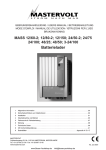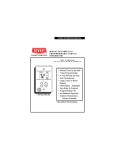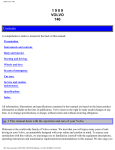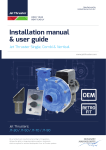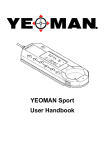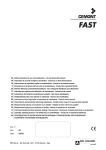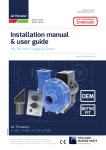Download Mastervolt MASS 12/30-2 Technical data
Transcript
GEBRUIKERSHANDLEIDING / USERS MANUAL BETRIEBSANLEITUNG / MODE D’EMPLOI MASS 12/30-2, 24/15-2, 24/25-2 battery charger 1 General information . . . . . . . . . . . . . . . . . . . . . . . . . . . . . . . . . . . . . . . . . . . . . . . . . . . . . . . . . . .10 2 Safety guidelines & measures . . . . . . . . . . . . . . . . . . . . . . . . . . . . . . . . . . . . . . . . . . . . . . . . . . .10 3 Technical data . . . . . . . . . . . . . . . . . . . . . . . . . . . . . . . . . . . . . . . . . . . . . . . . . . . . . . . . . . . . . . .11 4 Technology . . . . . . . . . . . . . . . . . . . . . . . . . . . . . . . . . . . . . . . . . . . . . . . . . . . . . . . . . . . . . . . . . 11 5 Installation . . . . . . . . . . . . . . . . . . . . . . . . . . . . . . . . . . . . . . . . . . . . . . . . . . . . . . . . . . . . . . . . . .12 6 Operation . . . . . . . . . . . . . . . . . . . . . . . . . . . . . . . . . . . . . . . . . . . . . . . . . . . . . . . . . . . . . . . . . . .14 7 Batteries . . . . . . . . . . . . . . . . . . . . . . . . . . . . . . . . . . . . . . . . . . . . . . . . . . . . . . . . . . . . . . . . . . .14 8 Trouble shooting . . . . . . . . . . . . . . . . . . . . . . . . . . . . . . . . . . . . . . . . . . . . . . . . . . . . . . . . . . . . . .15 9 Maintenance . . . . . . . . . . . . . . . . . . . . . . . . . . . . . . . . . . . . . . . . . . . . . . . . . . . . . . . . . . . . . . . .16 10 EC declaration of conformity . . . . . . . . . . . . . . . . . . . . . . . . . . . . . . . . . . . . . . . . . . . . . . . . . . . . .16 11 Data sheets . . . . . . . . . . . . . . . . . . . . . . . . . . . . . . . . . . . . . . . . . . . . . . . . . . . . . . . . . . .Apendix A 12 Installation sheet . . . . . . . . . . . . . . . . . . . . . . . . . . . . . . . . . . . . . . . . . . . . . . . . . . . . . . .Apendix B MASTERVOLT Snijdersbergweg 93, 1105 AN Amsterdam, The Netherlands Tel. +31-20-3422100 / Fax +31-20-6971006 V1. September 1999 GENERAL INFORMATION 1 / SAFETY GUIDELINES EN MEASURES GENERAL INFORMATION GARANTEE SPECIFICATIONS Mastervolt quarantees the performance of this Mass charger according to the specifications given in the data sheets, if installed and used as described in this manual. Should work take place, which is not in accordance with the guidelines, instructions and specifications contained in this user's manual and the supplementary installation manual, then damage may occur and/or the unit may not fulfil its specifications. All of these matters may mean that the guarantee may become invalid. The guarantee period is two years. 2 QUALITY During their production and prior to their delivery, all of our units are exhaustively tested and inspected. LIABILITY Mastervolt can accept no liability for: • damage due to use of the battery charger; • possible errors in the manual and the results thereof. SAFETY GUIDELINES & MEASURES USE FOR INTENDED PURPOSE The battery charger is contructed as per the applicable safety-technical guidelines. Use the battery charger only: 2 Check the wiring at least once a year. Defects such as loose connections, burned cables etc. must be corrected immediately. • for the charging of lead acid batteries and the supply of users attached to these batteries, in permanent systems; 3 Do not work on the charger or the system if it is still connected to a current source. Only allow changes in your electrical system to be caried out by qualified electricians. 4 Connection and protection must be done in accordance with local standards. 5 Before opening the cabinet of the charger, switch off the 230V mains and remove the charger fuse. • connected to a dedicated double pole circuit breaker (MCB); • with a fuse, protecting the wiring between charger output and battery; • in a technical correct condition; • in a closed, well-ventilated room, protected against rain, moist, dust and not condensing circumstances. Never use the battery charger at locations where there is danger of gas- or dust explosion! MAINTENANCE & REPAIR If the battery charger is switched off during maintenance and/or repair activities, it should be secured against unexpected and unintentional switching on: • switch off the AC circuit breaker; Use other than as mentioned under 2 is not considered to be consistent with the intended purpose. Mastervolt is not liable for any damage resulting from the above. SAFETY 1 Use only fuses with the prescribed current level: • AC supply fuse not greater than is required for the current consumption; • disconnect the charger; • switch off the connection with the batteries or remove the charger fuse; • be sure that third parties cannot reverse the measures taken. If such are required, use only original spare parts. • The charger fuse must be large enough for the maximal charger current and small enough to protect the charger‘s output cables. 10 August 1999 / MASS battery charger / EN TECHNICAL DATA / TECHNOLOGY 3 TECHNICAL DATA GENERAL Model Function apparatus Manufacturer MASS 12/30-2 battery charger/rectifier Mastervolt, Amsterdam MASS 24/15-2 MASS 24/25-2 INPUT Voltage Frequency Current Power factor Efficiency 230V, -10% +15% 50/60 Hz, ± 5 Hz 2.5A 1 88% 230V AC, -10% +15% 50/60 Hz, ± 5 Hz 2.5A 1 88% 230V, -10% +15% 50/60 Hz, ± 5 Hz 3.6A 1 88% OUTPUT Output voltage Output current (total max) Outputs Charge characteristic Kind of batteries Charge voltages (depending of phase) Ripple voltage Current Short circuit current Polarity control. nominal: 12V DC nominal: 24V DC 30A 15A 2 (1x30A max. 1xA max.) 2 (1x15A max. 1x3A max.) three-step, fully automatic, IUoUo open and sealed lead acid batteries / wet or gel 14.4V-13.25V 28.7V-26.5V max. 100mV rms, resistive load, full power 30 Amps 15 Amps 30 Amps 15 Amps polarity protected by means of a breaker nominal: 24V DC 25A 2 (1x25A max. 1x3A max.) 28.7V-26.5V 25 Amps 25 Amps ENVIRONMENTAL CHARACTERISTICS Operating ambient temperature -20 to +40°C; 100% output power Cooling forced, by means of a fan with variable speed Humidity max. 95% RV, not condensing ENCLOSURE Dimensions (hxwxd) Protection level Weight Safety 4 325x220x111 mm IP 22 2.6 kg IEC 335-2-29 TECHNOLOGY INTRODUCTION The MASS battery charger is a fully automatic high-efficient battery charger/rectifier,developed and produced by Mastervolt Amsterdam. The MASS series goes with a family of advanced quality battery chargers. Mastervolt distributes these products worldwide. The battery charger posseses an outstanding charging technique in order to charge batteries rapidly, safely and in the same time supply the connected consumers. In addition, the charger is secured against short circuit, overload and high temperatures in an industrial enviroment. THEORY OF OPERATION The MASS battery charger has a three-step charge characteristic (see fig. 1). EN / MASS battery charger / August 1999 Fig. 1 Example: Charge caracteristic MASS 12/15. (For other models V/A according to data sheets). 11 TECHNOLOGY / INSTALLATION Phase 1: Main charge (“BULK”) The first step “BULK” starts after switching on the MASS charger. In this phase, the charger supplies the maximum current until the battery reaches 14.40V. The battery is now 80% charged. When the battery reaches this limitation area the charge current wil decrease. Bulk duration is maximum 6 hours, depending on the battery’s condition and charge rate. The yellow “bulk” LED on the front panel will light up during this phase. Phase 2: “ABSORPTION” The second step “ABSORPTION” begins automatically with a voltage of 14.25V. The current consumption in the absorption mode is depending on the capacity of the batteries and will decrease slowly. The charger remains in this “absorption” phase untill the charge current drops for a periode of 15 minutes below 2.5A. If the charge current will not drop below 2.5A, a clock will switch the “absorption” mode off after 6 hours. During the absorption phase the yellow “ABSORPTION” LED on the front panel will light up. Phase 3: Trickle charge (“FLOAT”) The third stage, “FLOAT”, starts when the “absorption” phase has been completed. In the “float” mode, the charger automatically switches back to a lower output voltage of 13,25V. This voltage is sufficient to maintain the battery at a 100% charge. During this phase, the capacity of the charger can be entirely used for the supply of the users connected to the battery. During this mode the yellow “float” LED will light up. If necessary the charger automatically switches back to the “absorption” mode. Current consumption from mains or generator The charger produces no phase shift, because the input current follows the AC voltage waveform so a power factor of 1.0 or “unity” is achieved. The shape of the input current waveform is the same as the input voltage e.g. sinusoïdal. Therefore the input current is very low compared to conventional chargers. The charger has been programmed in such a way that a seperate sense connection to the battery is not necessary. CHARGING TWO OR MORE BATTERIES VIA ONE OUTPUT If two or more batteries need to be charged at the same time and output, a battery isolator should be used. The battery isolator divides the various battery sets from one other, in order to avoid one set discharging the other. Because there is always a voltage drop across the isolator of 0,7V the output voltage needs to be compensated. You can compensate this voltage drop by removing the “diode compensation” jumper on the front panel. CHARGING A CRANKING BATTERY In certain situations, it may occur that in addition to the main battery(ies) a cranking battery with the same voltage is used. The battery charger can charge a cranking battery at the same time as the main battery, by using the 3A output. The second output has the same output voltage as the main output, 3 Amps maximal ! THE BATTERY CHARGER AS FLOAT CHARGER It is possible to use the charger as a “trickle” charger. The charger then supplies a constant output voltage of 13.25V (26.5V). For this mode you can remove a jumper on the front. SELECTION WET OR GEL BATTERIES The optimal charge voltage for a wet lead acid battery differs from the gel battery. Therefore it is possible to switch over to a higher float voltage (13.8V for 12V and 27.6V for 24V) necessary for gel batteries. You increase this output voltage by removing a jumper on the front panel. 5 Low ripple on output The charger has a very low ripple on the output, which prevents interference in the DC circuit. The ripple is less than 100 mV with maximum output current. Automatic compensation of charge voltage with battery temperature If the temperature sensor is connected the MASS charger will charge its output voltage -30mV/°C (12V) or -60mV/°C (24V). The temperature sensor should give a good interpretation of the battery temperature. Automatic voltage sense compensation The charger compensates automatically for the normal voltage drop across the cable connection to the battery. 12 INSTALLATION Install the MASS battery charger in a dry, well ventilated area, as close as possible to the batteries. Although the battey charger has a high efficiency, some heat will be produced. This heat will be discharged by a fan with variable speed. At installation of the battery charger be sure that: • the air flow is not obstructed; • no water and/or dust can enter the cabinet. MOUNTING THE MASS CHARGER The charger can be either horizontal or vertical mounted. We recommend vertical, because the heat convection is from bottom to top. August 1999 / MASS battery charger / EN INSTALLATION WIRING AND CONNECTIONS When connecting any auxiliary equipment and/or a battery isolator, proceed as follows: • switch off the charger; • switch off the AC mains or generator supply; • isolate the DC distribution from the battery. Steps: 1 2 3 Battery wires Keep the cable connection between charger and battery as short as possible. If possible use coloured battery cables. I f this is not possible, mark the plus and the minus cables with coloured insulating tape, e.g. red for plus and blue for minus. Use the following diameters: lenght up to 3 meter 6 qmm lenght above 3 meter 10 qmm Connection of main batteries The minus cable (blue) on the -battery (minus connection) of the battery charger. The plus cable (red) on the + main battery (plus-connection) of the charger. The other side of the cable has to be connected to the battery or the DC distributor. The minus cable (blue) on the min-connection of the battery or DC divider. The plus cable (red) on the plus-connection of the battery or DC divider. Reversing the plus and the minus wil blow the fuse near to the minus connector ( the red LED above the fuse wil light up ). Before you replace the fuse check the polarity of the connections. Replace the fuse only for a 20A fuse. Too thin cables and/or loose connections can cause dangerous overheating of the cables and/ or terminals. Therefore tighten all connections properly, in order to limit as much as possible transition resistance, and use the battery cables with the correct diameter. Battery isolator If one or more batteries or battery sets must be charged at the same time via one output, a battery isolator should be used. A battery isolator isolates the different battery sets from one another, in order to prevent one discharging the other. A consequence of the battery isolator is a voltage drop of 0.7 Volt. This voltage drop can be compensated by removing a jumper on the front panel of the charger. Choose isolator type: 2 battery set MV 702 3 battery set MV 703 For proper installation, see the connection diagram included with the battery isolator. EN / MASS battery charger / August 1999 4 Check if the charger, the main supply and the DC divider are switched off. Connect the battery isolator(s) using cables with the same diameter as the battery cables. Compensate the voltage drop over these diodes by removing the “diode compensation” jumper on the front of the charger. Switch the charger on. Connection of cranking battery (3A output) The distance between charger and cranking battery determines the required, minimal cable diameter. For cable lenghts up to 6 meters 2,5 qmm must be used. When using long thin cables, it will take proportionately longer before a crancking battery is entirely charged. Therefore use, for longer distances, a larger diameter. The maximal charging current for the cranking battery is 3A. The charging current for the main battery will in this case be 3A lower. • Connect the minus of the cranking battery to the minus of the main battery. • Connect the plus of the cranking battery to the “BAT2” plus terminal of the charger. AC power supply Check the voltage of your mains source or generator. This must be between 190 and 250 VAC. Connect the mains cable on one side on the MASS charger and the opposite side to the mains or generator. ACCESSORIES When connecting accessories, first switch the charger „OFF” and disconnect from AC. Temperature sensor Mount the sensor at a location that gives a good indication of the battery temperature. Plug the connection cable into one of the input jacks of the charger. Basic remote panel Plug the connection cable into the analog input jack. Standard remote panel Plug the connection cable into the digital input jack. The communication protocol is based on quasi RS 232. Adjustment Interface & advanced remote panel Plug the connection cable into the digital input jack. The communication protocol is based on quasi RS 232. ADJUSTMENTS On the front of the charger you find three jumpers, each for a specific application. You can easily remove the jumpers with a pincet or a small pincer. 13 INSTALLATION / OPERATION / USING THE CHARGER WITH YOUR BATTERIES Switching off: The IVO charger will be switched off by the OFF switch. 7 Forced float For industrial applications only. Gel/wet battery By removing this jumper the output will be a constant “trickle charge” voltage of 13,8V. Diode compensation By removing this jumper the output voltage will be increased with 0,7 Volt. 6 USING THE CHARGER WITH YOUR BATTERIES CHARGING EFFICIENCY For a good performance your batteries should not be discharged below 30-40% of their capacity. Therefore always start charging at this level. As in marine and mobile systems often a limited charging time is desired, batteries are with generator use charged up to 85-90%. Charging up to 100% would take too long. This means that normally about 50% of the theoretical battery capacity can be used. In case a mains connection is present, charging time is less important. Then charging up to 100% is advised. OPERATION TIPS TO INCREASE THE BATTERY LIFETIME: 1 2 3 Check if the charger is „OFF”. Connect DC output with batteries or place fuse. Switch on AC source. Switching on: The MASS charger will be switched on by the ON switch. One of the front LEDS will light up now and the charging starts immediately. FLOAT: The battery charger is in a “trickle charge” mode, batteries are 100% charged. ABSORPTION: The batteries are still charging, charge level is approx. 80%. float charge 80 - 100 % absorption 50 % bulk charge - on • Charge the battery immediately after a consistent deep discharge.Especially at high environment temperatures, sulfating occurs very fast. If the state of sulfating is not too bad, the battery will regain a part of its capacity after a number of charge/recharge cycles. CHARGE INDICATOR INDICATOR LIGHTS • Install the batteries at a cool place. The acid in the batteries will damage the plates in a high temperature environment. A normal life time of 5 year at 20°C, will go down to 2.5 years at 30°C. off on BULK: The the the less charger supplies maximal voltage, battery charge is than 80%. charge failure MASS AUTOMATIC BATTERY CHARGER 14 August 1999 / MASS battery charger / EN TROUBLE SHOOTING 8 TROUBLE SHOOTING Malfunction Possible cause What to do No output voltage and/or current No AC mains or fuse blowes Check fuse, replace if necessary. Mains or generator output too low Check input voltage, must be between 190 and 260V (nominal 230V). Battery load consumes more than the charger can supply, the battery voltage cannot increase more Reduce the battery load taken from batteries. Batteries not 100% charged Measure the battery voltage after a while, this will be higher. Batteries almost fully charged Check if the charger is in the absorption mode. In this mode, the charge current will slowly decrease. High ambient temperature If the ambient temperature is more than 40°C, the maximum charge current automatically will be reduced. Mains too low When the mains is lower than 190V, the charger will regulate the current down. Batteries not fully charged Charge current too low Current to load too high Charge time too short Battery temperature too low Defective battery (short circuit in cell) Defective battery charger See “charge current too low”; Decrease the battery load; Increase type of charger; Use temperature sensor; Replace the battery; Check the charger. Battery very fast empty Battery capacity reduced because: • wastage • sulphating/stagnation Output voltage too low but charger supplies max. current Charge current too low Batteries are warm/gassing Defective batteries (short circuit in cell) Battery temperature too high Charge voltage too high Replace the batteries; Charge/discharge for several times, this might help, otherwise replace batteries. Replace batteries; Use temperature sensor; Check jumper ‘battery isolator’ on front panel. If you cannot solve the problem with this fault finding table, contact your Mastervolt Service Centre. For a detailed distributor list, please contact our main office in Amsterdam, tel. +31-20-3422100. EN / MASS battery charger / August 1999 15 MAINTENANCE 9 / EC DECLARATION MAINTENANCE The battery charger requires no specific maintenance. For a reliable and optimal function of the MASS battery charger only the following is required: • Check at least ones a year the wire and cable connections (loosen joints etc.). • Keep the MASS charger dry, clean and in a dust-free area, in order to ensure a good heat discharge. 10 EC DECLARATION OF CONFORMITY Manufacturer: Address: Herewith declares that: Product: Model: MASTERVOLT Snijdersbergweg 93 1105 AN AMSTERDAM Z.O. The Netherlands MASS MASS MASS MASS battery charger 12/30-2 24/15-2 24/25-2 Is in conformity with the provision of the EC EMC directive 89/336/EEC and amendments 92/31/EEC and 93/68/EEC. The following harmonized standards have been applied: Generic emission standard EN 50081-1:1992 Generic immunity standard EN 50082-1:1992 Amsterdam, Dr. F.J. ter Heide, Managing director MASTERVOLT 16 August 1999 / MASS battery charger / EN APENDIX A & B MASS 12/30-2, 24/15-2, 24/25-2 battery charger MASTERVOLT Snijdersbergweg 93, 1105 AN Amsterdam, The Netherlands Tel. +31-20-3422100 / Fax +31-20-6971006 V1. September 1999 34 DATA SHEETS 11 DATA SHEETS MASS 12/30-2 MAIN INFORMATION Design Manufacturer Model / name Product Article no Colour : : : : : : Weight excl. packing Shipping weight Cabinet typ Dimensions Carton dimensions Type of packing Available Availability : : : : : : : : by MASTERVOLT ISO 9001 certified MASS 12/30-2 battery charger/rectifier 04-00-10300 • RAL 5021, wasserblau • RAL 7037, grey 2.6 kg 4 kg MASS 1 cabinet hxwxd. 325 x 220 x 111 mm hxwxd. 350 x 250 x 160 mm carton recycable 230V / 50-60Hz normally from stock, from July ‘99 onwards Mass 12/30-2 battery charger/rectifier, art.no 04-00-10300, in new ‘high tech’ enclosure. Return Amps Min. Absorption time Max. Bulk/abs. time Return new cycle voltage Temperature compensation Voltage sense Ripple voltage Voltage accurancy Current accurancy Maximum output : : : : : : : : : : DC leakage drain Number of outputs AC/DC connections : : : Jumper selections : Remote indication Remote connection Temperature connection Smart controls : : : : Apendix A charging of 12V lead acid batteries and power simultanously loads 230V AC, 1ph, 3wire, 50/60 Hz 190..250V, 50/60 Hz, ± 5% 0..250V, 33-80 Hz at 230V AC: 2.5A no inrush current, soft start, according to IEC 1003-3 1, power factor controlled, IEC 555-2 550 Watt > 88% nominal 12V DC nominal 30 Amps three-step, fully automatic, IUoUo, programmable float charge 80 - 100 % open & sealed lead acid batteries • bulk voltage 14.40V • absorption 14.25V • wet float 13.25V • gel float 13.8V 2.5A absorption 50 % 15 minutes 6 hours 12.8V, delay 30 seconds bulk charge - on 30 mV/°C, by temperature sensor fully automatic compensation max. 100mV rms, resistive load, full power voltage ± 2% off current ± 3% • 30 Amps at 14.25 Volt at 25°C ambient on • 30 Amps at 13.25V at 40°C ambient < 10 mA charge failure one main outputs and one 3 Amps Slave Charger internal, min. AC cable size: 2.5 mm2 / min. DC cable size: 16 mm2 • gel/wet battery selection • forced to float AUTOMATIC • battery isolator compensation status bulk, absorption, float BATTERY CHARGER by telephone plug-in jack - RJ45 Standard control on unit. by telephone plug-in jack - RJ45 QRS232 output by telephone plug - RJ45 CHARGE INDICATOR TECHNICAL SPECIFICATIONS Function apparatus : Nominal input voltage : Input voltage range full specs : Input voltage range no-defects : Input current : Inrush current : Power factor : Max. input power : Efficiency : Output voltage : Output current : Charge characteristic : Kind of batteries : Charge voltage 25°C : MASS 35 DATA SHEETS TECHNICAL SPECIFICATIONS Short circuit proctection Reverse polarity protection Over heat : yes, reduced output max. 30 Amps : yes, by internal fuses : yes, derating output and shut off by 80°C temperature on heatsink Storage temperature Operating ambient temperature Humidity Vibration Cooling Forced cooling Environmental protection : : : : : : : Reliability/life time : • MTBF 30.000 hours • 1/4 life time period, Uin = 207V AC, Uout = 14,25, Iout = 30 Amps at Tamb 40°C • 3/4 life time period, Uin = 207V Ac, Uout = 13,25, Iout = 30 Amps at Tamb 25°C -25°C to 80°C -20°C to 40°C, derating with 2.5% / °C > 40°C maximum 95%, not condensing according IEC 68-2-6 mix of conventional and forced air cooling by one variable speed maintenance free DC fan IP21 ELECTRO MAGNETIC COMPATBILITY Electro Magnetic Emission : better than EN 50081-1 (gen. emmission standard, scope; residiential, commercial & light industry) Electro Magnetic Immunity : better than EN 50082-1 (gen. emmission standard, scope; residiential, commercial & light industry) Safety : according to IEC 335-2-29, polarity protected by means of a breaker, short break WHAT TO DO IN CASE OF A DEFECT? ✔ Consult factory in Amsterdam, tel. +31-20-3422100, or your local Repair Center. 200 58 48 83 41 101 111.2 6 10 Main PCB of the MASS 12/30-2. 10 220 Dimensions of the new cabinet and PCB. COMPLIANCES • CE: Is in conformity with the provision of the EC EMC directive 89/336/EEC and amandments 92/31/EEC, 93/68/EEC. The following harmonized standards have been applied: • Generic emission standard : EN 50081-1:1992 • Generic immunity standard : EN 50082-1:1992 • LLOYDS, DNV, ABS: MASTERVOLT has constructed this product for rugged circumstances in professional or leisure situations. This product can be type-approved individually. Price approx. US $ 1500 per certification. • MANUFACTURED UNDER ISO 9001. 36 Apendix A DATA SHEETS Main PCB of the MASS 12/30-2. New ‘high tech’ enclosure. ACCESSORIES Article no 04-15-00100 --04-15-00300 --00-17-05000 -- & REMOTES description basic remote control standaard remote contol advanced remote control MASS 1 temperature sensor MASS 1 cable set MASS 1 remote cable set Adjustment Interface Smart alarm control box LED’s LED’s current control display with owner’s settings SERVICE INFORMATION Article no description -sub assy, main PCB board -complete aluminium heatsink -cover module -connection module -front indicator module -installation blocks Adjustment Interface, art. no 02-17-05000. The below mentioned data can be adjusted with this digital instrument: • adjustment charge voltage (e.g. traction) • ‘return’ Amps etc. OPERATING PRINCIPLE Fully automatic power factor switch mode battery charger, suitable as power supply using a separate non-isolated pre regulator boost converter for power factor correction, followed by a double forward converter controlled by a combination of analogue hardware and microprocessor control. AC input DC output Aux. power supply PFC HARDWARE CONTROL SOFTWARE CONTROL remote Apendix A DC/DC select RS232 37 DATA SHEETS • Temperature variation 5.0 mV/°C per cell • Reference voltage 25°C • Battery charging is not allowed above +50°C and under -20°C • 12 Volt 30 mV/°C • 24 Volt 60 mV/°C 5.0 mV/°C Uref 25°C flo at ge l/w et ba tte dio ry de co m pe ns at ion Setpoint 30 sec. 30 mV/C 30 sec. 12.80 V 360 min. 15 min. 2.5 Amps 30 Amps 14.40 V 14.25 V 13.25 V 13.25 V 550 mV 600 mV 15.00 V 14.50 V 10.00 V 11.00 V 30 sec. ed Set points register Min. bulk time Temperature variation Return to bulk time Return to bulk voltage Max. bulk/abs time Min. abs time Return Amps Max. charge current Bulk voltage Abs voltage Float voltage Forced to float voltage Gel voltage setting Diode compensation setting DC high alarm on DC high alarm off DC low alarm on DC low alarm off Alarm delay time for c 1 2 3 4 5 6 7 8 9 10 11 12 13 14 15 16 17 18 19 standard IUU characteristic IUU char. increased with 0.6V IUU char. high float level IUU char. high float, increased with 0.6V IU char. low float level IU char. low float, increased with 0.6V IU char. high float level IU char. high float, increased with 0.6 V TEMPERATURE COMPENSATED CHARGING CHARGING CHARACTERISTICS 25°C reference temperature charging voltage in V 15.0 14.5 absorption 14.0 13.5 float 13.0 12.5 12.0 -30 -20 -10 0 10 20 30 40 50 60 battery temperature in °C min. bulk time MAX. BULK BULK TIME TOTAL CHARGE TIME CYCLE min. abs time return to bulk time ABS TIME FLOAT TIME NEW CYCLE MAX. OUTPUT VERSUS INPUT VOLTAGE 25°C reference temperature 25°C reference temperature Tamb= 25°C 35 14.25V 30 230V model 25 20 charging voltage in V current in Amps 40 Tamb= 40°C 15 80 100 120 140 160 180 200 220 240 260 input voltage 38 0 20 30 40 output current in Amps Apendix A DATA SHEETS DATA SHEETS MASS 24-15-2 MAIN INFORMATION Design Manufacturer Model / name Product Article no Colour : : : : : : Weight excl. packing Shipping weight Cabinet type Dimensions Carton dimensions Type of packing Available Availability : : : : : : : : by MASTERVOLT ISO 9001 certified MASS 24/15-2 battery charger/rectifier 04-00-20150 • RAL 5021, wasserblau • RAL 7037, grey 2.6 kg 4 kg MASS 1 cabinet hxwxd. 325 x 220 x 111 mm hxwxd. 350 x 250 x 160 mm carton recycable 230V / 50-60Hz normally from stock, from July ‘99 onwards TECHNICAL SPECIFICATIONS Function apparatus : Nominal input voltage : Input voltage range full specs : Input voltage range no-defects : Input current : Inrush current : Power factor : Max. input power : Efficiency : Output voltage : Output current : Charge characteristic : Kind of batteries : Charge voltage 25°C : Return Amps Min. Absorption time Max. Bulk/abs. time Return new cycle voltage Temperature compensation Voltage sense Ripple voltage Voltage accurancy Current accurancy Maximum output : : : : : : : : : : DC leakage drain Number of outputs AC/DC connections : : : Jumper selections : Remote indication Remote connection Temperature connection Smart controls : : : : Apendix A Mass 24/15-2 battery charger/rectifier, art.no 04-00-20150, in new ‘high tech’ enclosure. charging of 24V lead acid batteries and power simultanously loads 230V AC, 1ph, 3wire, 50/60 Hz 190..250V, 50/60 Hz, ± 5% 0..250V, 33-80 Hz at 230V AC: 2.5A no inrush current, soft start, according to IEC 1003-3 1, power factor controlled, IEC 555-2 550 Watt > 88% nominal 24V DC float charge 80 - 100 % nominal 15 Amps three-step, fully automatic, IUoUo, programmable open & sealed lead acid batteries • bulk voltage 28.7V • absorption 28.5V absorption 50 % • wet float 26.5V • gel float 27.6V 1.25A 15 minutes bulk charge - on 3 hours 25.6V, delay 30 seconds 60 mV/°C, by temperature sensor fully automatic compensation off max. 100mV rms, resistive load, full power voltage ± 2% on current ± 3% • 15 Amps at 28.5 Volt at 25°C ambient charge failure • 15 Amps at 26.5V at 40°C ambient < 5 mA one main outputs and one 3 Amps Slave Charger internal, min. AC cable size: 2.5 mm2 / min. DC cable size: 16 mm2 AUTOMATIC • gel/wet battery selection • forced to float BATTERY CHARGER • battery isolator compensation Standard control on unit. status bulk, absorption, float by telephone plug-in jack - RJ45 by telephone plug-in jack - RJ45 QRS232 output by telephone plug - RJ45 CHARGE INDICATOR 11 MASS 39 DATA SHEETS TECHNICAL SPECIFICATIONS Short circuit proctection : yes, reduced output max. 15 Amps Reverse polarity protection : yes, by internal fuses Over heat : yes, derating output and shut off by 80°C temperature on heatsink Storage temperature Operating ambient temperature Humidity Vibration Cooling Forced cooling Environmental protection : : : : : : : -25°C to 80°C -20°C to 40°C, derating with 2.5% / °C > 40°C maximum 95%, not condensing according IEC 68-2-6 mix of conventional and forced air cooling by one variable speed maintenance free DC fan IP21 Reliability/life time : • MTBF 30.000 hours • 1/4 life time period, Uin = 207V AC, Uout = 28.5, Iout = 15 Amps at Tamb 40°C • 3/4 life time period, Uin = 207V Ac, Uout = 26.5, Iout = 15 Amps at Tamb 25°C ELECTRO MAGNETIC COMPATBILITY Electro Magnetic Emission : better than EN 50081-1 (gen. emmission standard, scope; residiential, commercial & light industry) Electro Magnetic Immunity : better than EN 50082-1 (gen. emmission standard, scope; residiential, commercial & light industry) Safety : according to IEC 335-2-29, polarity protected by means of a breaker, short break WHAT TO DO IN CASE OF A DEFECT? ✔ Consult factory in Amsterdam, tel. +31-20-3422100, or your local Repair Center 200 58 48 83 41 101 111.2 6 10 Main PCB of the MASS 24/15-2. 10 220 Dimensions of the new cabinet and PCB. COMPLIANCES • CE: Is in conformity with the provision of the EC EMC directive 89/336/EEC and amandments 92/31/EEC, 93/68/EEC. The following harmonized standards have been applied: • Generic emission standard : EN 50081-1:1992 • Generic immunity standard : EN 50082-1:1992 • LLOYDS, DNV, ABS: MASTERVOLT has constructed this product for rugged circumstances in professional or leisure situations. This product can be type-approved individually. Price approx. US $ 1500 per certification. • MANUFACTURED UNDER ISO 9001. 40 Apendix A DATA SHEETS Main PCB of the MASS 24/15-2. New ‘high tech’ enclosure. ACCESSORIES & REMOTES Article no description 04-15-00100 --04-15-00300 --00-17-05000 -- basic remote control LED’s standaard remote contol LED’s current control advanced remote control display with owner’s settings MASS 1 temperature sensor MASS 1 cable set MASS 1 remote cable set Adjustment Interface Smart alarm control box SERVICE INFORMATION Article no description ------- sub assy, main PCB board complete aluminium heatsink cover module connection module front indicator module installation blocks Adjustment Interface, art. no 02-17-05000. The below mentioned data can be adjusted with this digital instrument: • adjustment charge voltage (e.g. traction) • ‘return’ Amps etc. OPERATING PRINCIPLE Fully automatic power factor switch mode battery charger, suitable as power supply using a separate non-isolated pre regulator boost converter for power factor correction, followed by a double forward converter controlled by a combination of analogue hardware and microprocessor control. AC input DC output Aux. power supply PFC HARDWARE CONTROL SOFTWARE CONTROL remote Apendix A DC/DC select RS232 41 DATA SHEETS Setpoint 30 sec. 60 mV/C 30 sec. 25.60 V 360 min. 15 min. 1.25 Amps 15 Amps 28.70 V 28.50 V 26.50 V 26.50 V 1.10 V 600 mV 30 V 29 V 20 V 22 V 30 sec. • Temperature variation 5.0 mV/°C per cell • Reference voltage 25°C • Battery charging is not allowed above +50°C and under -20°C • 12 Volt 30 mV/°C • 24 Volt 60 mV/°C 5.0 mV/°C flo at ge l/w et ba tte dio ry de co m pe ns at ion Uref 25°C ed Set points register Min. bulk time Temperature variation Return to bulk time Return to bulk voltage Max. bulk/abs time Min. abs time Return Amps Max. charge current Bulk voltage Abs voltage Float voltage Forced to float voltage Gel voltage setting Diode compensation setting DC high alarm on DC high alarm low DC low alarm on DC l ow alarm off Alarm delay time for c 1 2 3 4 5 6 7 8 9 10 11 12 13 14 15 16 17 18 19 standard IUU characteristic IUU char. increased with 0.6V IUU char. high float level IUU char. high float, increased with 0.6V IU char. low float level IU char. low float, increased with 0.6V IU char. high float level IU char. high float, increased with 0.6 V TEMPERATURE COMPENSATED CHARGING CHARGING CHARACTERISTICS 25°C reference temperature 30 29 charging voltage in V 30 28 29 27 absorption 26 28 25 27 24 float 26 25 24 -30 -20 -10 0 10 20 30 40 50 60 min. bulk time MAX. BULK BULK TIME TOTAL CHARGE TIME CYCLE battery temperature in °C min. abs time ABS TIME ABS TIME return to bulk time FLOAT TIME NEW CYCLE MAX. OUTPUT VERSUS INPUT VOLTAGE 25°C reference temperature 25°C reference temperature 30 29 15 14.25V 230V model 10 charging voltage in V current in Amps 20 Tamb= 25°C 28 Tamb= 40°C 27 26 25 24 80 100 120 140 160 180 200 220 240 260 input voltage 42 0 7.5 15 output current in Amps Apendix A DATA SHEETS 11 DATA SHEETS MASS 24/25-2 MAIN INFORMATION Design Manufacturer Model / name Product Article no Colour : : : : : : Weight excl. packing Shipping weight Cabinet type Dimensions Carton dimensions Type of packing Available Availability : : : : : : : : by MASTERVOLT ISO 9001 certified MASS 24/25-2 battery charger/rectifier 04-00-20250 • RAL 5021, wasserblau • RAL 7037, grey 2.6 kg 4 kg MASS 1 cabinet hxwxd. 325 x 220 x 111 mm hxwxd. 350 x 250 x 160 mm carton recycable 230V / 50-60Hz normally from stock, from July ‘99 onwards Mass 24/25-2 battery charger/rectifier, art.no 04-00-20250, in new ‘high tech’ enclosure. Return Amps Min. Absorption time Max. Bulk/abs. time Return new cycle voltage Temperature compensation Voltage sense Ripple voltage Voltage accurancy Current accurancy Maximum output : : : : : : : : : : DC leakage drain Number of outputs AC/DC connections : : : Jumper selections : Remote indication Remote connection Temperature connection Smart controls : : : : Apendix A charging of 24V lead acid batteries and power simultanously loads 230V AC, 1ph, 3wire, 50/60 Hz 190..250V, 50/60 Hz, ± 5% 0..250V, 33-80 Hz at 230V AC: 3.6A no inrush current, soft start, according to IEC 1003-3 1, power factor controlled, IEC 555-2 800 Watt > 88% nominal 24V DC nominal 25 Amps three-step, fully automatic, IUoUo, programmable float charge 80 - 100 % open & sealed lead acid batteries • bulk voltage 28.7V • absorption 28.5V • wet float 26.5V • gel float 27.6V absorption 50 % 1.25A 15 minutes 6 hours 25.6V, delay 30 seconds bulk charge - on 60 mV/°C, by temperature sensor fully automatic compensation max. 100mV rms, resistive load, full power off voltage ± 2% current ± 3% on • 25 Amps at 28.5 Volt at 25°C ambient • 25 Amps at 26.5V at 40°C ambient < 5 mA charge failure one main outputs and one 3 Amps Slave Charger internal, min. AC cable size: 2.5 mm2 / min. DC cable size: 16 mm2 • gel/wet battery selection • forced to float AUTOMATIC • battery isolator compensation BATTERY CHARGER status bulk, absorption, float by telephone plug-in jack - RJ45 Standard control on unit. by telephone plug-in jack - RJ45 QRS232 output by telephone plug - RJ45 CHARGE INDICATOR TECHNICAL SPECIFICATIONS Function apparatus : Nominal input voltage : Input voltage range full specs : Input voltage range no-defects : Input current : Inrush current : Power factor : Max. input power : Efficiency : Output voltage : Output current : Charge characteristic : Kind of batteries : Charge voltage 25°C : MASS 43 DATA SHEETS TECHNICAL SPECIFICATIONS Short circuit proctection : yes, reduced output max. 25 Amps Reverse polarity protection : yes, by internal fuses Over heat : yes, derating output and shut off by 80°C temperature on heatsink Storage temperature Operating ambient temperature Humidity Vibration Cooling Forced cooling Environmental protection : : : : : : : -25°C to 80°C -20°C to 40°C, derating with 2.5% / °C > 40°C maximum 95%, not condensing according IEC 68-2-6 mix of conventional and forced air cooling by one variable speed maintenance free DC fan IP21 Reliability/life time : • MTBF 30.000 hours • 1/4 life time period, Uin = 207V AC, Uout = 28.5, Iout = 25 Amps at Tamb 40°C • 3/4 life time period, Uin = 207V Ac, Uout = 26.5, Iout = 25 Amps at Tamb 25°C ELECTRO MAGNETIC COMPATBILITY Electro Magnetic Emission : better than EN 50081-1 (gen. emmission standard, scope; residiential, commercial & light industry) Electro Magnetic Immunity : better than EN 50082-1 (gen. emmission standard, scope; residiential, commercial & light industry) Safety : according to IEC 335-2-29, polarity protected by means of a breaker, short break WHAT TO DO IN CASE OF A DEFECT? ✔ Consult factory in Amsterdam, tel. +31-20-3422100, or your local Repair Center. 200 58 48 83 41 101 111.2 6 10 Main PCB of the MASS 24/25-2. 10 220 Dimensions of the new cabinet and PCB. COMPLIANCES • CE: Is in conformity with the provision of the EC EMC directive 89/336/EEC and amandments 92/31/EEC, 93/68/EEC. The following harmonized standards have been applied: • Generic emission standard : EN 50081-1:1992 • Generic immunity standard : EN 50082-1:1992 • LLOYDS, DNV, ABS: MASTERVOLT has constructed this product for rugged circumstances in professional or leisure situations. This product can be type-approved individually. Price approx. US $ 1500 per certification. • MANUFACTURED UNDER ISO 9001. 44 Apendix A DATA SHEETS Main PCB of the MASS 24/25-2. ACCESSORIES Article no 04-15-00100 --04-15-00300 --00-17-05000 -- & REMOTES description basic remote control standaard remote contol advanced remote control MASS 1 temperature sensor MASS 1 cable set MASS 1 remote cable set Adjustment Interface Smart alarm control box New ‘high tech’ enclosure. LED’s LED’s current control display with owner’s settings SERVICE INFORMATION Article no description -sub assy, main PCB board -complete aluminium heatsink -cover module -connection module -front indicator module -installation blocks Adjustment Interface, art. no 02-17-05000. The below mentioned data can be adjusted with this digital instrument: • adjustment charge voltage (e.g. traction) • ‘return’ Amps etc. OPERATING PRINCIPLE Fully automatic power factor switch mode battery charger, suitable as power supply using a separate non-isolated pre regulator boost converter for power factor correction, followed by a double forward converter controlled by a combination of analogue hardware and microprocessor control. AC input DC output Aux. power supply PFC HARDWARE CONTROL SOFTWARE CONTROL remote Apendix A DC/DC select RS232 45 DATA SHEETS Setpoint 30 sec. 60 mV/C 30 sec. 25.60 V 360 min. 15 min. 1.25 Amps 25 Amps 28.70 V 28.50 V 26.50 V 26.50 V 1.10 V 600 mV 30 V 29 V 20 V 22 V 30 sec. • Temperature variation 5.0 mV/°C per cell • Reference voltage 25°C • Battery charging is not allowed above +50°C and under -20°C • 12 Volt 30 mV/°C • 24 Volt 60 mV/°C 5.0 mV/°C flo at ge l/w et ba tte dio ry de co m pe ns at ion Uref 25°C ed Set points register Min. bulk time Temperature variation Return to bulk time Return to bulk voltage Max. bulk/abs time Min. abs time Return Amps Max. charge current Bulk voltage Abs voltage Float voltage Forced to float voltage Gel voltage setting Diode compensation setting DC high alarm on DC high alarm off DC low alarm on DC low alarm off Alarm delay time for c 1 2 3 4 5 6 7 8 9 10 11 12 13 14 15 16 17 18 19 standard IUU characteristic IUU char. increased with 0.6V IUU char. high float level IUU char. high float, increased with 0.6V IU char. low float level IU char. low float, increased with 0.6V IU char. high float level IU char. high float, increased with 0.6 V TEMPERATURE COMPENSATED CHARGING CHARGING CHARACTERISTICS 25°C reference temperature 30 charging voltage in V 30 29 28 29 27 absorption 28 26 25 27 24 float 26 25 24 -30 -20 -10 0 10 20 30 40 50 60 min. bulk time MAX. BULK BULK TIME TOTAL CHARGE TIME CYCLE battery temperature in °C min. abs time ABS TIME ABS TIME return to bulk time FLOAT TIME NEW CYCLE MAX. OUTPUT VERSUS INPUT VOLTAGE 25°C reference temperature 25°C reference temperature 30 28.5V 230V model 20 15 10 5 Tamb= 25°C 28 Tamb= 40°C 27 26 25 24 0 80 100 120 140 160 180 200 220 240 260 input voltage 46 29 charging voltage in V current in Amps 25 0 12.5 25 output current in Amps Apendix A NOTES NOTES Apendix B 47 C-3-RS panel code part number 07-04-03040 MASTERVISION MODULAR SWITCHBOARDS SPECIFICATIONS CAUTION 1. Lethal voltages exist on your vessel. Make sure all shore power, onboard generating sources and batteries are disconnected before beginning installation of your electrical panel. description: type: remote standard charger control for Mass & IVO smart chargers 2. AC modules will have lethal voltages on the bus bars and terminals. The coating on these bars is for identification only and should not be relied on as a insulator. Additional safety enclosures may be required in some installations. dimensions panel (wxh): panel depth: 120 x 65 mm 40 mm 3. Make sure all AC modules are bonded to the shipís AC ground bus. When grouping modules together to form your panel, a single ground may be used. Use a resistance meter to verify ground to all modules. Charger Control float The standard remote panel absorption The standard remote panel is a useful power device for remote control of the Mass an IVO smart Mastervolt battery chargers. The standard remote control does indicate the status of the charge control by six high power leds and control the output current by setting the potential meter. The remote control is easy to install by a plug-in standard twisted six pole RJ45 telephone plug between the digital rs232 output of the charger and the panel. The serial communication of the remote control and the charger is based on rs232 technology. The remote panel can be used as an interface for a custom made panel or for a dual remote indicator. The standard remote panel has a CSI (csi=charger status interface) and a DC high/low alarm. The two potential free change-over contacts indicate if the charger is ON or in general failure. The DC alarm set points can be adjusted in the charger by use of the adjustment interface. Specifications Remote cable: Connector RJ45, 6 pole, male Max length 6 meter, max Type twisted wire External led drive: Imax 5 mA Umax 2,5V External current control R pot cc 0..1kOhm 0..100% General CSI alarm Max rating 1 Amp, 30 VDC NC-on When the charger is off or the charger is in failure, the normally closed contact is closed C Common NO-on When the charger is on and no-failure is indicated the normally open contact is closed DC-high/low alarm (combined function with CSI) Max rating 1 Amp, 30 VDC NC-on When there is no DC failure, the normally closed contact is closed C Common NO-on When there is a DC failure the normally open contact is closed Connectors 0,75 mm2 48 on - bulk charge current output failure external current control DC alarm normally closed normally open common external LED failure external LED bulk external LED 20-40% external LED absorption CSI alarm normally closed normally open common external LED 60-80% external LED float charger 6 pole telephone jack RJ 45 CSI failure Bat TC failure Voltage sense failure Sys. temp. failure Short break indicator Battery temperature sensor out of range <20 C & >60 C Voltage sense out of range >3 VDC Charger is out of temperature range "overload" (>75--85 C) Charger in reduced current mode (short break mode) Uout <4..5VDC DC alarm Battery range out of range (with standard setting of charger) 12V 24V DC low on 10.0 20.0 VDC DC low off 11.0 22.0 VDC DC high on 16.0 32.0 VDC DC high off 15.0 30.0 VDC Delay time 30 30 SEC September 1999 / MASS 12/30, 24/15 and 24/25 battery charger / EN C-4-RB panel code part number 07-04-04100 MASTERVISION MODULAR SWITCHBOARDS SPECIFICATIONS CAUTION 1. Lethal voltages exist on your vessel. Make sure all shore power, onboard generating sources and batteries are disconnected before beginning installation of your electrical panel. description: type: remote basic charger control for Mass & IVO smart chargers 2. AC modules will have lethal voltages on the bus bars and terminals. The coating on these bars is for identification only and should not be relied on as a insulator. Additional safety enclosures may be required in some installations. dimensions panel (wxh): panel depth: 60 x 65 mm 40 mm 3. Make sure all AC modules are bonded to the shipís AC ground bus. When grouping modules together to form your panel, a single ground may be used. Use a resistance meter to verify ground to all modules. The basic remote panel Charger Charger Control Control float Inverter Control Charger Control Charger Output on The basic remote panel is a useful power device for remote control of the Mass an Ivo smart Mastervolt battery chargers. The basic remote control does indicate the status of the charge control by six high power leds. The remote control is easy to install by a plug-in standard twisted six pole RJ45 telephone plug between the analog output of the charger and the panel. The communication of the remote control and charger is based on analog technology. The remote panel can be used as an interface for a custom made panel or for a dual remote indicator. The basic remote panel has a combined CSI-DC/alarm (csi=charger status interface). The potential free change-over contacts indicate if the charger is ON or in general failure. The DC alarm set points can be adjusted in the chargers by use of the adjustment interface. on on failure absorption failure float failure absorption float on - bulk charge bulk absorption failure bulk current control common C normal open normal closed alarm contact NC NO DC+CSI Specifications external LED failure external LED bulk General CSI alarm Max rating 1 Amp, 30 VDC NC-on When the charger is off or the charger is in failure, the normally closed contact is closed C Common NO-on When the charger is on and no-failure is indicated the normally open contact is closed Connectors 0,75 mm2 external LED 20-40% 5 mA 2,5V external LED absorption External led drive: Imax Umax external LED 60-80% RJ45, 6 pole, male 6 meter, max twisted wire external LED float Remote cable: Connector Max length Type 6 pole telephone jack RJ 45 charger Combined CSI failure and DC high/low alarm Bat TC failure Voltage sense failure Sys. temp. failure Short break indicator DC alarm These products fully comply to the latest CE norms in force from Januari 1st 1996 and are produced to ISO 9001 standards. ISO 9001 EN / MASS 12/30, 24/15 and 24/25 battery charger / September 1999 Battery temperature sensor out of range <20°C & >60°C Voltage sense out of range >3 VDC Charger is out of temperature range ìoverloadî (>75--85 C) Charger in reduced current mode (short break mode) Uout <4..5VDC Battery range out of range (with standard setting of charger) 12V 24V DC low on 10.0 20.0 VDC DC low off 11.0 22.0 VDC DC high on 16.0 32.0 VDC DC high off 15.0 30.0 VDC Delay time 30 30 SEC 49 NOTES NOTES 50 September 1999 / MASS 12/30, 24/15 and 24/25 battery charger / EN Charger Control float absorption on - bulk charge current output failure external current control Charger Charger Control Control float Inverter Control Charger Control Charger Output on on on failure absorption failure float failure DC alarm normally closed normally open common CSI alarm normally closed normally open common 6 pole telephone jack RJ 45 absorption float on - bulk charge bulk absorption failure bulk external LED failure external LED bulk external LED 20-40% current control external LED absorption external LED 60-80% external LED float alarm contact charger common C normal open normal closed NC DC+CSI external LED failure external LED bulk external LED 20-40% external LED absorption external LED 60-80% external LED float 6 pole telephone jack RJ 45 charger MASTERVOLT Snijdersbergweg 93, 1105 AN Amsterdam, The Netherlands Tel.: +31-20-3422100 Fax: +31-20-6971006 NO



























